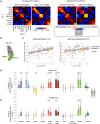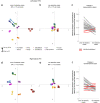Longitudinal development of category representations in ventral temporal cortex predicts word and face recognition
- PMID: 38049393
- PMCID: PMC10696026
- DOI: 10.1038/s41467-023-43146-w
Longitudinal development of category representations in ventral temporal cortex predicts word and face recognition
Abstract
Regions in ventral temporal cortex that are involved in visual recognition of categories like words and faces undergo differential development during childhood. However, categories are also represented in distributed responses across high-level visual cortex. How distributed category representations develop and if this development relates to behavioral changes in recognition remains largely unknown. Here, we used functional magnetic resonance imaging to longitudinally measure the development of distributed responses across ventral temporal cortex to 10 categories in school-age children over several years. Our results reveal both strengthening and weakening of category representations with age, which was mainly driven by changes across category-selective voxels. Representations became particularly more distinct for words in the left hemisphere and for faces bilaterally. Critically, distinctiveness for words and faces across category-selective voxels in left and right lateral ventral temporal cortex, respectively, predicted individual children's word and face recognition performance. These results suggest that the development of distributed representations in ventral temporal cortex has behavioral ramifications and advance our understanding of prolonged cortical development during childhood.
© 2023. The Author(s).
Conflict of interest statement
The authors declare no competing interests.
Figures




References
-
- Carey S, Diamond R, Woods B. Development of face recognition - a maturational component? Dev. Psychol. 1980;16:257–269. doi: 10.1037/0012-1649.16.4.257. - DOI
Publication types
MeSH terms
Grants and funding
LinkOut - more resources
Full Text Sources

